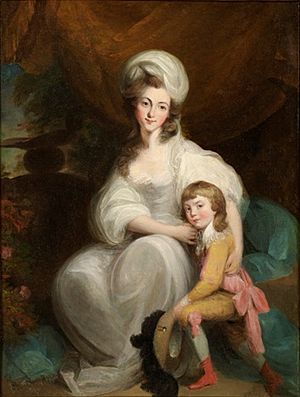James Hay, Lord Hay facts for kids
James Hay, Lord Hay (born around 1797 – died June 16, 1815) was a young officer in the British Army. He was sadly killed during the famous Waterloo Campaign, a series of battles that ended the Napoleonic Wars.
Contents
Who Was James Hay?
James Hay was the son of William Hay, 17th Earl of Erroll and his wife, Alicia Eliot. His father held an important noble title, "Earl of Erroll," in Scotland.
His Military Role
James Hay was a junior officer, known as an ensign, in a famous British army unit called the 1st Foot Guards. He served as a special assistant, or aide-de-camp, to General Maitland.
On June 16, 1815, James Hay was killed during the Battle of Quatre Bras. This battle was a very important fight that happened just two days before the main Battle of Waterloo. If James had lived, he would have inherited his father's title, becoming the next Earl of Erroll. However, because he died, his younger brother, William, became the Earl instead.
A Young Officer's Excitement
In 1899, a magazine called Murray's Magazine shared some memories from Georgiana, Dowager Lady De Ros. She was the daughter of the Duchess of Richmond. She remembered a famous party, the Duchess of Richmond's ball, which took place on June 15, 1815, just before the battles began.
Lady De Ros recalled how excited young Lord Hay was about going into battle. He was a "dashing merry youth" who looked forward to earning honors. She was "quite provoked" (meaning a bit annoyed but also worried) by his eagerness. The very next day, on June 16, the sad news arrived that both he and the Duke of Brunswick had been killed.
Where He Rests
Around 1890, James Hay's remains were moved. They now rest in a special crypt under The British Waterloo Campaign Monument. This monument is located in The Brussels Cemetery in Evere, Belgium.
James Hay in Stories
James Hay's story has been told in books and movies, even though he was a real person.
In the Movie Waterloo
In the 1970 film Waterloo, James Hay is played by British actor Peter Davies. In the movie, he is shown as a main character, often by the side of Wellington, the famous British general.
- At the Duchess of Richmond's ball, he dances with the Duchess's daughter, Sarah. The movie shows them as being in love and even formally engaged.
- The Duchess tells Wellington, "Don't let young Hay get killed," showing her concern.
- Later in the film, Hay serves alongside the Duchess's brother, the Duke of Gordon.
- Wellington tells Hay that he is "a lucky fellow" to see such a huge army in his first battle.
- The movie shows Hay's last words as "Think of England, men, think of England!" However, these words were likely created for the film.
- He is then hit in the head by a bullet and dies instantly.
In the Novel An Infamous Army
James Hay also appears in Georgette Heyer's 1937 novel, An Infamous Army. This book tells the story of the events around Waterloo through the eyes of made-up characters. However, it also includes real people and describes actual historical events, like James Hay's role.


